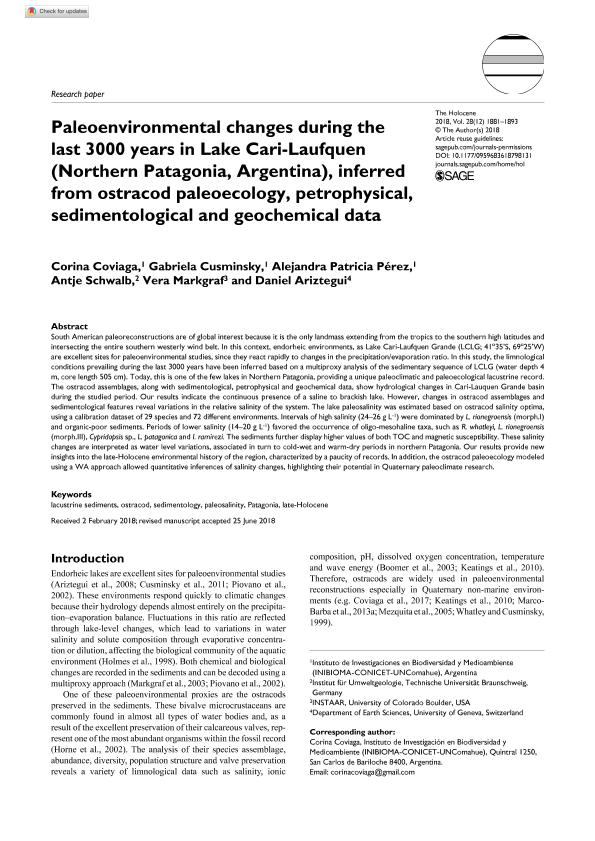Artículo
Paleoenvironmental changes during the last 3000 years in Lake Cari-Laufquen (Northern Patagonia, Argentina), inferred from ostracod paleoecology, petrophysical, sedimentological and geochemical data
Coviaga, Corina Anabel ; Cusminsky, Gabriela Catalina
; Cusminsky, Gabriela Catalina ; Perez, Alejandra Patricia
; Perez, Alejandra Patricia ; Schwalb, Antje; Markgraf, Vera; Ariztegui, Daniel
; Schwalb, Antje; Markgraf, Vera; Ariztegui, Daniel
 ; Cusminsky, Gabriela Catalina
; Cusminsky, Gabriela Catalina ; Perez, Alejandra Patricia
; Perez, Alejandra Patricia ; Schwalb, Antje; Markgraf, Vera; Ariztegui, Daniel
; Schwalb, Antje; Markgraf, Vera; Ariztegui, Daniel
Fecha de publicación:
08/2018
Editorial:
SAGE Publications
Revista:
Holocene (Seven Oaks)
ISSN:
0959-6836
Idioma:
Inglés
Tipo de recurso:
Artículo publicado
Clasificación temática:
Resumen
South American paleoreconstructions are of global interest because it is the only landmass extending from the tropics to the southern high latitudes and intersecting the entire southern westerly wind belt. In this context, endorheic environments, as Lake Cari-Laufquen Grande (LCLG; 41º35’S, 69º25’W) are excellent sites for paleoenvironmental studies, since they react rapidly to changes in the precipitation/evaporation ratio. In this study, the limnological conditions prevailing during the last 3000 years have been inferred based on a multiproxy analysis of the sedimentary sequence of LCLG (water depth 4 m, core length 505 cm). Today, this is one of the few lakes in Northern Patagonia, providing a unique paleoclimatic and paleoecological lacustrine record. The ostracod assemblages, along with sedimentological, petrophysical and geochemical data, show hydrological changes in Cari-Lauquen Grande basin during the studied period. Our results indicate the continuous presence of a saline to brackish lake. However, changes in ostracod assemblages and sedimentological features reveal variations in the relative salinity of the system. The lake paleosalinity was estimated based on ostracod salinity optima, using a calibration dataset of 29 species and 72 different environments. Intervals of high salinity (24–26 g L-1) were dominated by L. rionegroensis (morph.I) and organic-poor sediments. Periods of lower salinity (14–20 g L-1) favored the occurrence of oligo-mesohaline taxa, such as R. whatleyi, L. rionegroensis (morph.III), Cypridopsis sp., L. patagonica and I. ramirezi. The sediments further display higher values of both TOC and magnetic susceptibility. These salinity changes are interpreted as water level variations, associated in turn to cold-wet and warm-dry periods in northern Patagonia. Our results provide new insights into the late-Holocene environmental history of the region, characterized by a paucity of records. In addition, the ostracod paleoecology modeled using a WA approach allowed quantitative inferences of salinity changes, highlighting their potential in Quaternary paleoclimate research.
Archivos asociados
Licencia
Identificadores
Colecciones
Articulos(INIBIOMA)
Articulos de INST. DE INVEST.EN BIODIVERSIDAD Y MEDIOAMBIENTE
Articulos de INST. DE INVEST.EN BIODIVERSIDAD Y MEDIOAMBIENTE
Citación
Coviaga, Corina Anabel; Cusminsky, Gabriela Catalina; Perez, Alejandra Patricia; Schwalb, Antje; Markgraf, Vera; et al.; Paleoenvironmental changes during the last 3000 years in Lake Cari-Laufquen (Northern Patagonia, Argentina), inferred from ostracod paleoecology, petrophysical, sedimentological and geochemical data; SAGE Publications; Holocene (Seven Oaks); 28; 2; 8-2018; 1881-1893
Compartir
Altmétricas



